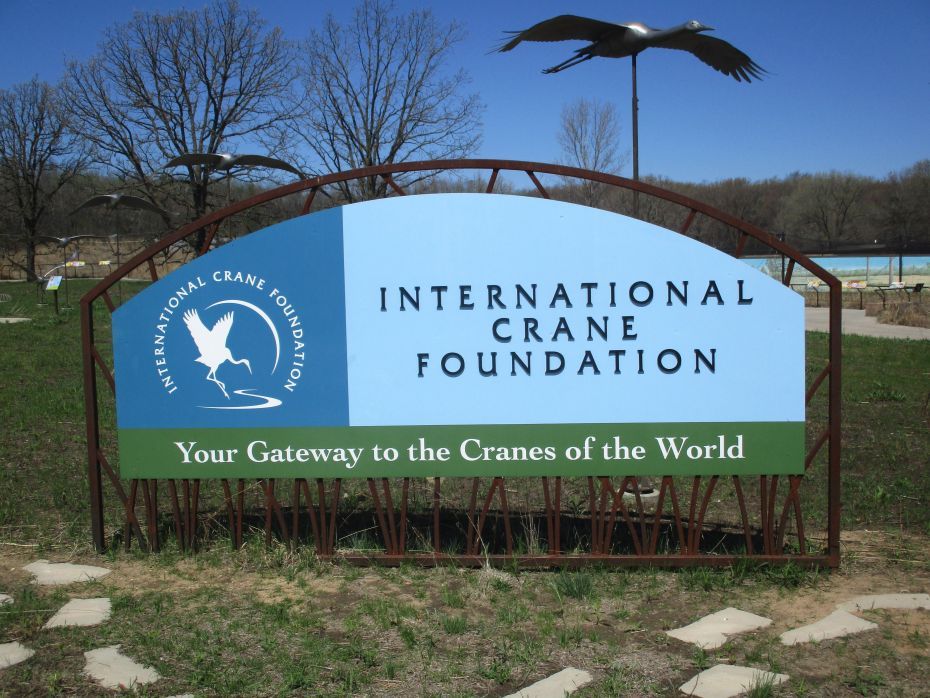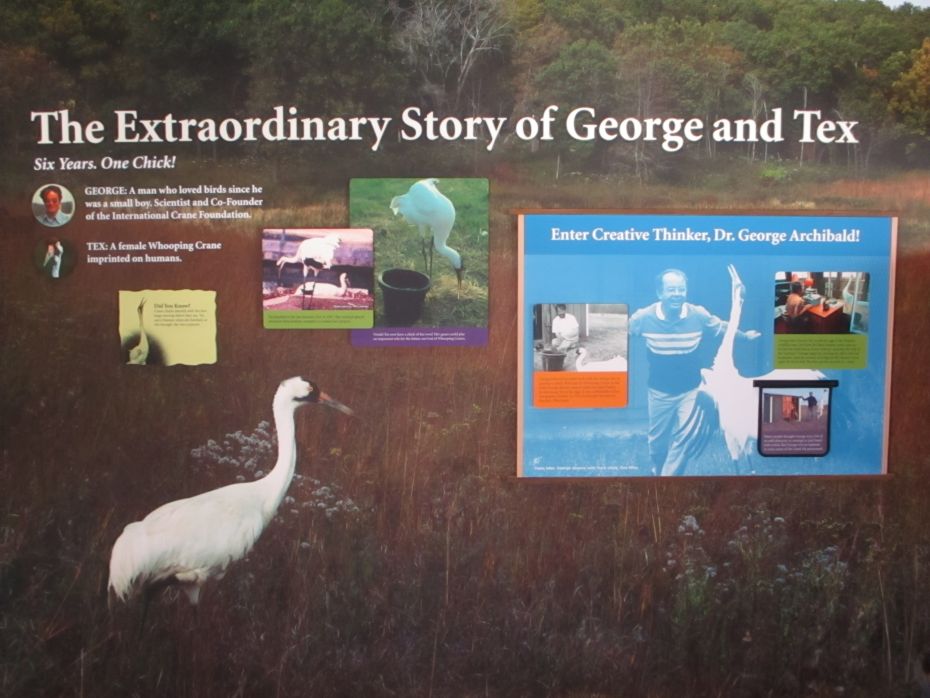|
International Crane Foundation -- Bird Conservation in the
Midwest
Story and
photographs by Tom Straka

Roughly halfway between Chicago
and Minneapolis (very close to Wisconsin Dells) is an engaging
travel stop which centers on bird conservation, specifically on
all 15 species of cranes worldwide. There are conservation and
ecology lessons, natural outdoor exhibits with many of the crane
species, and even crane-related artwork. It is the
International Crane
Foundation (ICF) and the
interesting aspect to the visitor is the Crane Discovery Center,
an introduction to all things crane. The ICF's work spans four
key regions: North America, Asia, Africa, and their global
headquarters in Wisconsin.
First, a little background on the
ICF. It was founded in 1973 by two Cornell University
ornithology graduate students who shared a passion for cranes.
They envisioned an organization combining research, captive
breeding and reintroduction, landscape restoration, and
education to safeguard the world's crane species. The
organization is headquartered near Baraboo, Wisconsin. Today
they have offices and staff in China, Uganda, Kenya, Zambia,
South Africa and Texas (aligning with the migration patterns of
the world's crane populations).
They are still a very active
organization, as ten of the world's 15 crane species are facing
extinction. The ICF's
goal
is to protect cranes and the ecosystems, watersheds and flyways
on which they depend, while providing knowledge, leadership, and
inspiration to engage people in resolving threats to cranes and
their diverse landscapes.
The Crane Discovery Center sits on
nearly 300 acres along with the global headquarters. It hosts a
captive flock of approximately 100 cranes, including the only
complete collection of all 15 species worldwide. The site, which
features live crane exhibits, guided and self-guided tours, a
research library, a welcome center, and four miles of nature
trails, is visited by more than 25,000 people annually.

A
nearly level paved trail system moves from exhibit to exhibit. A
linked nature trail system is not so level and wanders through
natural areas on the property.
Once you leave the Discovery
Center building, with displays and a cool gift shop, you are on
a system of paved "trails" which lead to a series of live crane
displays (linked to another system of real trails which allow
exploration of the local nature). While there are fences to keep
the cranes in place, the enclosures are anything but zoo-like.
The 300 acres allows for large natural areas for each crane
species. There is plenty of signage to explain migration routes
and crane particulars.

The
sarus crane
ranges over Asia, from India and Nepal to Vietnam, and as far
south as Australia. The total population is about 15,000 to
20,000 birds. Sarus cranes are the tallest flying birds in the
world. They stand six feet tall!

The
wattled crane
has a range in Southern and Central Africa. Slightly more than
9,000 birds exist. Their nests can be nearly six feet wide.
Wattled cranes are the most wetland-dependent of all African
crane species and rely on seasonal floods to feed and breed.

The
demoiselle crane
breeds manly in Kazakhstan and Mongolia and winters in India and
northeastern Africa. The population is roughly 200,000 birds.
Demoiselle cranes are the smallest crane species and the least
dependent on wetlands, preferring open grasslands. They are
known for their spectacular migration over the Himalayas in
Nepal, flying as high as 26,000 feet.

The
grey crowned crane
is an African crane with a population of around 30,000 birds.
Its "crown" is made of feathers, specially adapted to help it
blend in with tall grasses and avoid predators.
There is much more along the trail besides crane enclosures,
especially much artwork, crane-related, scattered among the
exhibits. Plus, exhibits explaining crane behavior and some of
the history of the early efforts to develop the techniques
needed to work with cranes and crane populations. For example,
imprinting
was an early problem. This occurs in "precocial" birds
(ground-nesting birds which hatch with down feathers and open
eyes and the ability to leave the nest within hours of hatching;
as opposed to songbirds which hatch naked and blind, and are
dependent on their parents for food) where imprinting is a rapid
learning process where young birds follow and identify the first
large moving object they see as a parent. They quickly learn
their parents' behavior and physical characteristics. Should the
hatchling first see a human, that becomes the source of parental
imprinting, and the bird would consider itself a human.
To
solve the imprinting problem
the keepers were required to wear a crane costume (white robe
with head covering, a crane puppet on their hand, and parental
crane call recording in their pocket). There are some
interesting stories
of early problems involving cranes imprinted with humans. I
guess you could call them
crane-human love stories.

Displays highlight interesting crane stories, like the "love
story" from the beginning of the ICF with one of its
founders and Tex,
a female whooping crane.

Displays also discuss important foundations of the ICF, like why
it is important to save animal species from
extinction.
Notice the passenger pigeon (extinct) and the American bison and
whooping crane (so far avoiding extinction).

When entering the site, Bill Sullivan's sculpture of a set of
four of a single whooping crane taking flight greets the
visitor. Above are the first two showing the beginning of
flight.

Other artwork (in addition to that on the walls of the Discovery
Center building) is scattered among the outdoor exhibits.

Some of the artwork is unusual. These are Buddhist prayer
wheels. These are found in India, Nepal, Bhutan, and other
countries. For many Buddhists, spinning a prayer wheel is
equivalent to a spoken prayer. Cranes are revered in both Hindu
and Buddhist traditions.

The
red-crowned crane
is one of the heaviest cranes, weighing up to 25 pounds. The
range is Asia and about 3,000 birds exist. It is in trouble due
to habitat destruction from diversion of water to cities and
destruction of wetlands for agriculture and development. There
are two distinct populations--one migrates and one does not.

The
black-necked crane
is Asian. About 10,000 exist. China has set aside dozens of
natural nature reserves to protect the species.

The
Siberian crane
is critically endangered; about 4,000 still exist. It migrates
between northern Siberia and South Asia. The red color on its
head is actually bare skin.

The
brolga
ranges from Australia, Indonesia, and Papua New Guinea. Less
than 100,000 still exist. It utilizes the same grassland where
cattle graze. The name is Australian Aboriginal.
You don't have to be a "birder" to enjoy the International Crane
Foundation. There is much natural history and really interesting
outdoor exhibits. Plus, lots of environmental philosophy.
The Ho-Chunk people (local Native Americans) appreciated the
natural pattern of the cranes and one exhibit gives the story:
"In the spring, the cranes arrive home to Wisconsin, the
homeland of the Ho-Chunk people. Upon their arrival, they call
out, signifying that the people should get their seeds and soil
prepared for the upcoming growing season. As the warm summer
days turn to the colder season of fall, the cranes prepare for
their migration south, and they call out again. They remind the
people to gather their black ash baskets for the corn and squash
harvest time."
Author/Photographer.
Tom Straka is an emeritus professor of forestry at Clemson
University in South Carolina. He has an interest in history,
forestry and natural resources, natural history, and the
American West.
Public
Disclosure Please Read FTC has a law
requiring web sites to let their readers know if any of the
stories are 'sponsored' or compensated. We also are to
let readers know if any of our links are ads. Most are not.
They are just a way to direct you to more information
about the article where the link is placed. We have several ads
on our pages. They are clearly marked as ads. I think
readers are smart enough to know an ad when they see one but to
obey the letter of the law, I am putting this statement here to
make sure everyone understands. American Roads and Global
Highways may contain affiliate links or ads. Further, as their
bios show, most of the feature writers are professional travel
writers. As such we are frequently invited on press trips, also
called fam trips. On these trips most of our lodging, dining,
admissions fees and often plane fare are covered by the city or
firm hosting the trip. It is an opportunity to visit places we
might not otherwise be able to visit. However, no one tells us
what to write about those places. All opinions are 100% those
of the author of that feature column.
| 


